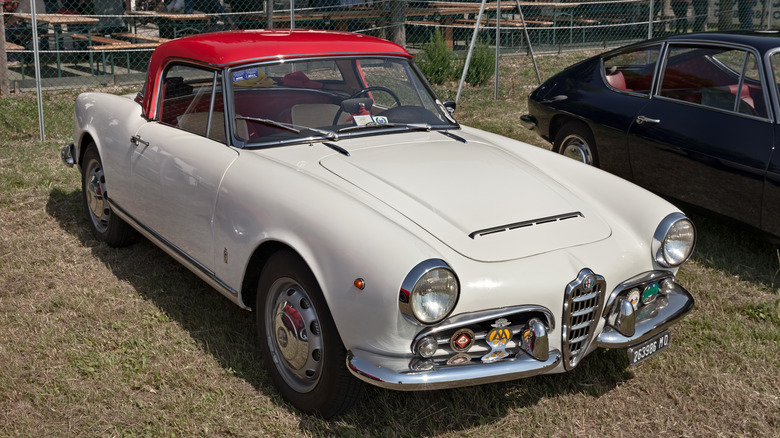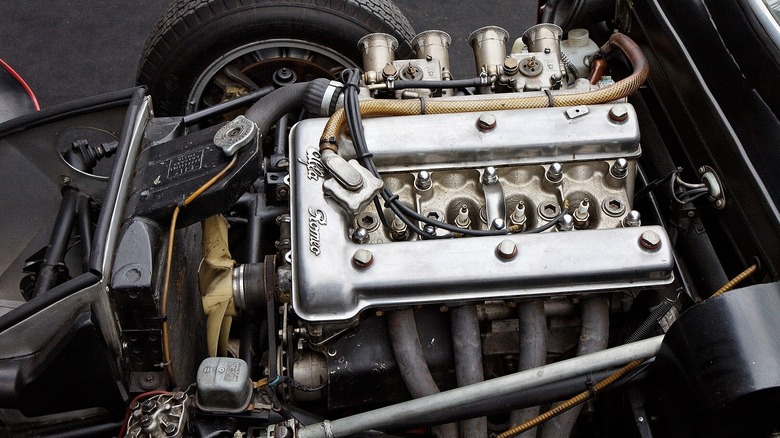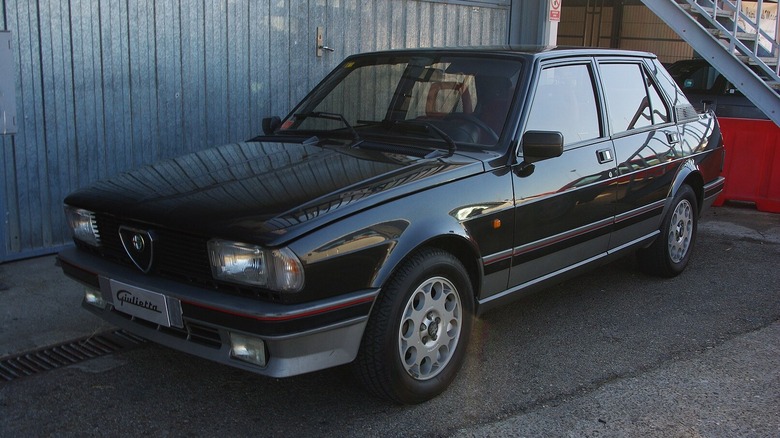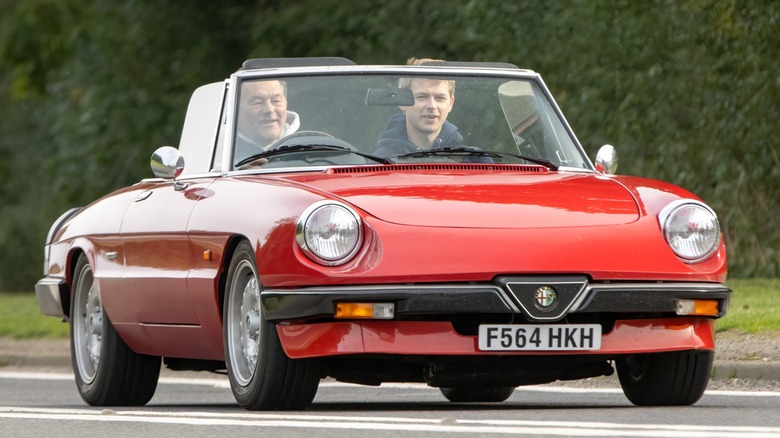Everything To Know About Alfa Romeo's Twin Cam Engine
From Alfa Romeo's stiletto-heel elegant Tonale SUV to the Giulia GTA so stylish it let each customer design their own racing livery, the Milan automaker has a rich history of building beautiful performance cars. With decades of outstanding racing and road-going car history, there is a lot to unpack. However, one outstanding constant throughout the lineage of Alfa Romeo cars both on track and on the road is the Twin-Cam engine. As one might assume based on the name, it's a dual-overhead-camshaft engine. What one wouldn't assume from the name, though, is that this engine had an amazing production lifespan that lasted an unprecedented 40 years.
The Alfa Romeo Twin-Cam (commonly referred to as "Bialbero") is a four-cylinder engine that started its life way back in 1954. Alfa Romeo set out to produce a durable, lightweight engine using aluminum alloy for the cylinder block. The design had hemispherical combustion chambers and a matching aluminum alloy cylinder head. As we've established, that cylinder head featured a pair of camshafts. They're driven by a timing chain and each camshaft was adjustable independently of the other to allow for timing changes. That said, as you might imagine, the engine went through a few changes in 40 years.
The Twin-Cam's Early Years
The Alfa Romeo Giulietta was the first car to sport this engine. With 1.3 liters of displacement, the Twin-Cam offered between 53 and 100 horsepower depending on the car's trim level. The low-end model, the Giulietta Berlina, used a single carburetor setup and still managed a top speed of around 87 miles per hour — not bad for 1954. Sprint and Spider models got a double-choke carb setup and a higher compression ratio for 65 horsepower. At the top of the line, improved exhaust manifolds, more aggressive camshafts, and dual carbs provided the most power output.
By 1962, Alfa Romeo released the next car with the Twin-Cam engine: the company's legendary Giulia. The Twin-Cam in the Giulia was actually a ground-up redesign that required new factory tooling to build. As with the Giulietta, the most potent variant came with a pair of side-draft carburetors.
The most potent of them all, though, was the 1965 Giulia Sprint GTA. It was a proper race car, built to compete in touring car races. The Twin-Cam got a substantial power boost courtesy of 45mm carbs and a racing-engine-specific cylinder head. Increased air flow and dual spark plugs for more efficient fuel use netted a total output of 115 horsepower. This car and engine combo went on to win the Division 2 European Touring Car Championship in 1966, 1967, and 1969.
[Featured image by Thesupermat via Wikimedia Commons | Cropped and scaled | CC BY-SA 3.0]
Turbos come to the Twin-Cam
As is the case with many brands, Alfa Romeo took to turbocharger technology in the 1980s. Also like many other brands in the 1980s, the most hardcore and sought-after road-going cars were born because of racing. Namely, rally racing.
Alfa Romeo built two turbocharged homologation cars in the 1980s to meet homologation regulations for rally. The first was the 1983 Giuelietta Turbodelta. They were developed by Autodelta, the racing branch of Alfa Romeo. The company needed to produce 400 road-going turbo homologation cars. Ultimately, though, only 361 were ever built. The road-going cars didn't come with intercoolers, so the boost remained quite low. However, a small, turbocharged Italian sports car from the 1980s still sounds like a pretty good time! One particularly interesting tidbit about the Giulietta Turbodelta is the fact that, despite its forced induction, the turbo Twin-Cam engine still uses a pair of Weber carburetors.
The next turbocharged Twin-Cam Alfa came in the form of the 1986 Alfa Romeo 75 Turbo. Unlike the Giulietta, the turbo Twin-Cam found in the 75 Turbo used fuel injection and an intercooler. Alongside a Garrett turbocharger, the 1.8-liter variant of the staple Twin-Cam engine made 155 horsepower. It wasn't just the turbocharger helping net these power outputs, though. The Twin-Cam also featured another technology: variable valve timing.
[Featured image by ALFACORSECLUB TU CLUB ALFA ROMEO via Wikimedia Commons | Cropped and scaled | CC BY 2.0]
Twin-Cam brings Variable Valve Timing to the World
Let's step back a bit. Though the 1986 Alfa Romeo 75 Turbo did indeed feature variable valve timing, it wasn't the first time Alfa engineers fitted this technology to the Twin-Cam engine. In 1980, the American-delivered Alfa Romeo Spider became not only the first Alfa Romeo to use variable valve timing but the first production car ever offered with variable valve timing. Alfa then brought the technology to Europe with the 1984 Alfetta Quadrifoglio Oro.
Alfa Romeo achieved variable valve timing by way of a variator that allowed timing on intake valves to change. This technology became standard on all Alfa Romeo Twin-Cam engines throughout the company's lineup by 1989.
The final version of the iconic Alfa Romeo Twin-Cam came with two liters of displacement, fuel injection, and a total power output of 120 horsepower. Unfortunately, after the 1994 model year, Alfa Romeo removed its offerings from the U.S. market and discontinued the Spider model. In turn, it also ended the production of the iconic Twin-Cam engine exactly 40 years after it first hit the market. Of course, Alfa Romeo did make a recent triumphant return to the U.S. market with a handful of top-market models, notably including 2021's Stradale Tributo racing-inspired supercar, but the Twin-Cam engine remains a thing of the past



